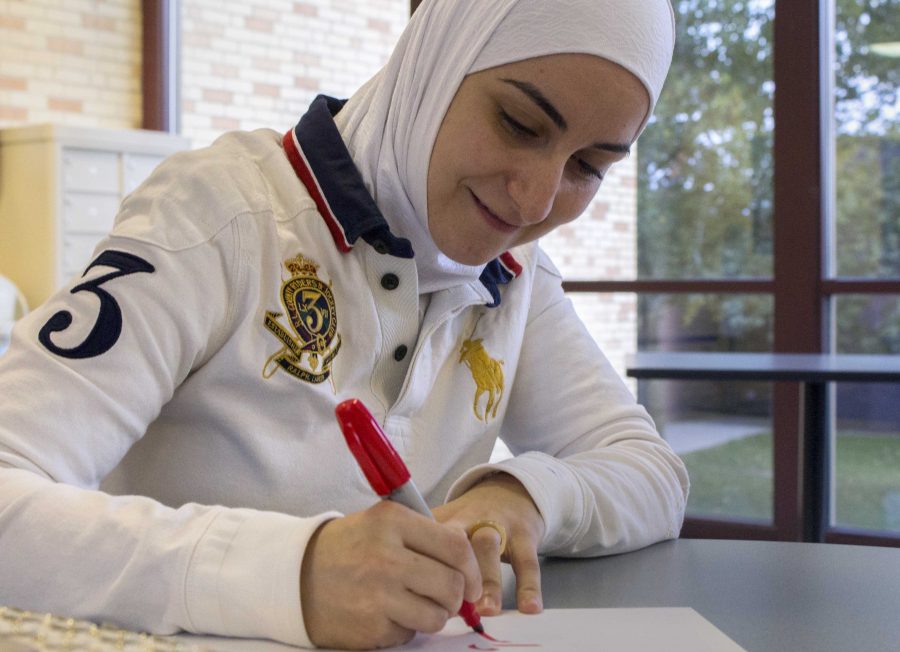Speaker challenges narrative about Muslim Americans
October 11, 2016
Through a combination of candid dialogue and anecdotes, storyteller and social media personality Aman Ali sought to humanize the experiences of Muslim Americans.
“The Other 1%: Muslims in America,” hosted by the University Board, featured an hour-long presentation by Ali, along with lessons in Arabic calligraphy, traditional food and an informational booth created by the Muslim Student Association.
Ali said growing up, he and his traditional family were the only Muslims in his small Ohio town, so he often felt left out, especially during the holidays.
Ali also spoke about his experiences traveling around the U.S. for his blog “30 Mosques in 30 Days,” during which he visited 30 mosques in 30 different states for each day of Ramadan.
He told a story about his car breaking down in the middle of nowhere in North Dakota after driving into a rock, which forced him to detour to a tiny mosque for his evening meal. He said he was shocked to learn that Muslim American farmers had been on the land for seven generations, without any serious conflict with their neighbors.
Ali said he kept seeing this pattern throughout his travels — Muslims, Christians and others living peacefully together.
“What I see on television very often is not remotely reflective of the average ordinary Muslim American,” he said. “I became fascinated by questioning these narratives of how people perceive Muslims.”
Ali emphasized the importance of exploring other cultures.
“One of the big takeaways from my visits (to mosques) was the importance of getting out of your comfort zone,” he said.
To do this, he suggested more Christians visit mosques and more Muslims visit churches.
Ali, a former journalist, said he does not think there is an anti-Muslim bias in the news, but that journalists are not without blame.
“We live in a society where whoever shouts the loudest gets the most airtime,” Ali said. “Even if I say something stupid, if I yell it, it’s going to get airtime.”
He said he thinks social media can break the cycle of negativity, as ordinary people can simply tell their stories.
Nevertheless, he said responsible journalism will always play a role in society, as “credible people are always needed.”
Kinesiology professor Hasan Mavi, who serves as adviser for the Muslim Student Association, said he believed correcting misinformation was key to building bridges between Muslims and non-Muslims.
He said many people think Muslims worship a different God from Jews and Christians. However, Allah means “the God” in Arabic.
“If you read an Arabic Bible, it’ll say ‘Allah.’ We believe in the same God,” Mavi said.
Mavi said Muslims are often criticized for not speaking out against violence, but in reality, their voices are not often reported.
He said too many journalists focus on violence, minimizing the accomplishments of Muslims in areas like science and literature.
For Eastern students who wish to learn more about Islamic culture, Mavi recommended they visit the Cultural Center Friday afternoons, when Muslims on campus join for prayer.
He said other instructors can reach out to him to have Muslim students come to classes to have a panel discussion on their religion.
At “The Other 1%,” Arabic calligraphy artist Hassan Qureshi taught a group of students the basics of the art starting with “alif,” the first letter of the Arabic alphabet.
Students then practiced writing the Arabic word for “hope.”
Qureshi said he learned Arabic calligraphy using YouTube videos and was drawn to the art because it is methodical and beautiful.
He said there is a spiritual component to calligraphy.
“I often find myself losing track of time in practice,” he said.
Meagan Ramey, a senior biological sciences major, said she attended the event because she wanted to support the Muslim community.
“I think the Muslim people are oppressed in America, and I wanted to show them love,” Ramey said.
Leon Mire can be reached at 581-2812 or lkmire@eiu.edu.




































































